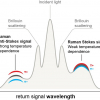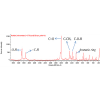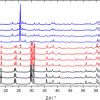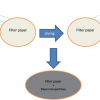Peter White and Timothy Wilkinson
DeCipher Pte Ltd, Unit 5, Begbroke Science Park, Begbroke Hill, Woodstock Road, Begbroke, Oxford, OX5 1PF, UK. E-mail: [email protected]
Introduction
Worldwide trading malpractice from smuggling, counterfeiting, theft and product diversion is estimated to cost over $800 billion annually (~7% of World Trade) and is one of the biggest brakes on the growth of companies and economies. This illegal trade occurs across most industrial sectors and is particularly significant for fuels. Countries often tax fuel products to generate revenues to support and stimulate their economy. In addition, Governments will often subsidise the cost of essential products. These initiatives for taxing fuel consumption and for providing subsidised fuel are, themselves, subject to fraud. Oil manufacturing companies also suffer from fuel fraud with the loss of legitimate sales and with additional quality and liability issues.
Whilst the amount of losses will influence the decision of a country to implement a control programme, this is not often the main determinant as, in some countries, these losses end up in corrupt pockets. The main driving forces behind influencing whether a country implements a programme are: the level of taxation of fuel products and if the tax is a significant part of its overall revenue. The higher the proportion the fuel tax is of the overall revenue, the more seriously the issue of fuel trading will be taken. Another driving force is that countries, in particular developing countries, also need to protect internal investment, especially when oil multi-national companies are major players as these need to protect their investment. If countries also have fuel subsidy programmes in which the subsidies are to be used to aid poor communities or please particular sectors, for example, farmers, then they may consider the introduction and implementation of a fuel control programme.
Other factors include the size and loss of revenue from fuel fraud and whether the country is a crude oil importer or exporter. Losses will be less important if it is earning significant revenues from fuel exports. In contrast, when a country is importing fuel, any loss will hurt financially. Countries also wanting to improve their image and international status may also consider introducing fuel control programmes. In addition to any country’s decision, oil marketing companies may seek some control programme to provide revenue, brand and liability protection.
Fuel control programmes have been implemented in several countries, with monitoring of fraudulent use being achieved by the addition of a marker into a fuel and subsequent analyses of fuel samples. The level of marker detected will depend upon whether it is non-adulterated or adulterated with another fuel either being subsided or non-subsidised. A reduction or loss in marker concentration could also be indicative of laundering, in which a chemical or absorbent material has been added to the fuel to remove the marker illegally. Hence, any analytical technique used should be able to detect and identify trace levels of markers.
A range of analytical methods has been used to detect the markers in fuels including gas chromatography-mass spectrometry (GC-MS), immunoassay, X-ray, infrared and UV spectroscopy, but these often lack the desired sensitivity and/or specificity and are often too expensive. It was proposed by one of the authors (PW) that surface-enhanced Raman scattering (SERS) spectroscopy may be a viable alternative, since it can offer the desired sensitivity, provide molecular recognition and is also capable of simultaneous detection of more than one marker.
The surface enhancement effect was discovered by Martin Fleischmann about 40 years ago1 and, although back in the 1980s many analysts identified the advantages that SERS could offer, it is only more recently that its full potential has been realised. This delay can be attributed to there being no commercially-available SERS substrate that met the demands of the analysts as specified in Michael Natan’s summary of a Faraday Discussion Group meeting in 2006.2 These included an acceptable shelf-life, good batch-to-batch reproducibility, a high enhancement factor and cost.
A silver colloid has generally been the preferred substrate and many different synthetic methods have been reported but none have, until recently, been able to fully meet these specifications. A breakthrough came in 2009, when White and Hjortkjaer developed and patented a method for producing a stable silver colloid that could meet and, in most instances, exceed all the specifications.3,4
With a suitable substrate now available, this opened up the potential for commercial applications and the opportunity to see if the proposed SERS-based method could be used for detecting fuel fraud. Working with a fuel-marking company (DeCipher), a simple and rapid method was developed within six months. Following successful pilot studies and development of a portable Raman instrument, several countries chose this novel SERS method for the detection of fuel fraud, hence making this the first major commercial and forensic application of SERS spectroscopy.
Details of the SERS method that has been developed for the detection of fuel fraud are described within this article but, unfortunately, certain information, including the SERS reagents/solutions, identity of the markers and marking protocols used in the field, cannot be divulged for proprietary and contractual reasons. However, the results presented here will be used to highlight the demands required of any analytical method being used for this particular application. Finally, the advantages of using SERS over more traditional analytical techniques that have been used previously for fuel fraud detection are also presented.
Samples
Fuel samples, including diesel, gasoline and kerosene, were marked with at least one SERS active compound (marker) at a level of typically 50–200 ppb by dissolving the marker in a solvent that is compatible with the fuel.
Analytical approach
Aware that there is a need for a quick, reliable and robust procedure that can be used in the field by operatives who may have no scientific experience, a single tube method for the SERS detection of the marker was developed. This could be achieved because it was found that, although the silver colloid is in aqueous solution and, therefore, immiscible with a fuel, the negatively charged silver particles aid the extraction of any marker present in the fuel across into the colloidal aqueous phase. When this is performed in a glass vial, a SERS spectrum of the aqueous phase can be obtained without any further manipulation. Typically, a marked fuel sample is prepared for SERS analysis as follows. Silver colloid solution diluted with water [500 µL; colloid / water 30 : 70 (v / v)] is added to a 1.0 mL screw-capped glass vial (Chromacol) containing an aliquot (500 µL) of the marked fuel sample. After capping the vial and vortex mixing for 3 × 3 s, the sodium chloride aggregating reagent solution (40 µL; 0.175 M) is added, the cap replaced and inverted twice to mix the components.
The SERS analyses are performed on a portable instrument that was developed, in partnership with Ocean Optics Inc., specifically for this application as it was required to meet demanding specifications. Obviously, cost is a major factor and, for operation in the field and laboratory, a portable and robust instrument which could be operated by a mains or battery supply was required. The instrument also had to be capable of producing unique spectra of more than one marker which could be used to identify and quantify the levels of markers present in fuels. To be able to successfully prosecute any fraudulent use of fuels, it was essential that the system could verify samples and provide secure and tamper-free storage of data.
For the field instrument, a major requirement was that it should also be capable of providing a simple qualitative “Yes/No” output to show which marker/markers is/are present and yield quantitative results and also be able to transmit the full data from the field to base. Since drawing up these specifications, the current instrument, as shown in Figure 1, now meets all these requirements.

The instrument is fitted with a 30 mW, 532 nm diode laser as the excitation source and spectra are recorded over a range of 200–2000 cm–1 using a cooled CCD detector. After preparing a sample, the glass vial is inserted into the sample holder and, from typically a 1 × 30 s scan, a spectrum is recorded. The instrument control and data obtained are all processed through software installed on an inboard computer. The extraction and SERS protocols developed enable the whole of this analytical process to be completed in about five minutes.
Fuel samples, including diesel, gasoline and kerosene, were marked with at least one SERS active compound (marker) at a level of typically 50–200 ppb by dissolving the marker in a solvent that is compatible with the fuel.
Results and discussion
The silver colloid used was prepared as described in the Patent3 and from extended use in this application it has proved to be stable for over a year and the method produces batches which deliver reproducible SERS spectra. To ensure the quality of the colloid being produced, QA procedures, including the use of UV-visible spectra and particle sizing, are used. The colloid typically produced contains silver particles with a narrow particle size distribution of 10–30 nm centred at 20 nm, as illustrated in Figure 2. A UV-visible spectrum of the colloid is also presented in Figure 3.


As indicated above, the colloid is negatively charged and this results from the method of preparation used which produces silver particles with phosphate anions adsorbed onto their surface. To some extent, this does limit the range of markers that can be used, since only positively charged markers will be attracted to the silver surface and yield strong SERS spectra.
Clearly, the markers used must be SERS-active and they must be detected in a fuel at <5% of the marking level. However, for any analytical technique being proposed for fuel fraud detection programmes, the markers selected must meet other additional and stringent requirements including:
- being stable in the fuel and carrier solvent
- having specific detection characteristics with no false positives
- having no effect on the fuel
- being detected by a simple and fast test procedure with simple instrumentation
- giving a consistent reading and having the same result in all fuels
- being detectable after attempts at laundering with acid, alkali or common absorbents
- being detectable in a small volume of fuel to reduce volume of waste material
- exhibiting a low level of degradation in sunlight.
To date, over 200 potential markers have been tested to see if they meet the above requirements, of which a significant number have been identified as being suitable. Ideally, markers with a λmax close to the laser excitation wavelength are preferable, since increased sensitivity due to the resonance effect will be obtained—surface enhanced resonance Raman scattering (SERRS) spectroscopy.5
In one of the early pilot trials, the SERS detection was evaluated alongside a diesel marking system already in operation. This allowed a direct comparison of results of the two different detection methods being used to identify the marker in the fuel samples. Of the 500 field samples analysed by the SERS method, the marker was positively identified in every sample and no false positives were obtained. The operatives also reported that they found the SERS method to be cleaner, faster, provided permanent data and wasted only 0.5 mL of the fuel.
The cost and logistics of marking is a major issue as the volume of fuel to be marked may be many thousands of litres. The cost of the marker together with the cost and volume of carrier solvents must be considered very carefully and, hence, the solubility of the marker in the carrier solvent is a very important consideration. To achieve a marker concentration of typically 100 ppb, 10 mL of a 1% marker concentrate needs to be dispersed into 1000 litres of fuel. The marking of fuel in the field is either carried out manually or by automatic injectors, as illustrated in Figure 4.

There are occasions when more than one marker is required, for example to differentiate the source of the fuel. This is important when, for example, road fuel is subsidised at a different rate to industrial fuel. In addition, if wanting to mark different fuels such as diesel, gasoline, kerosene or biofuels, or to identify different grades of a fuel or regional malpractice, these would all require more than one marker. This need to identify and quantify multiple markers at trace levels in a single analysis severely limits the choice of analytical technique but, as illustrated in Figure 5, this can be achieved with the SERS detection system where markers A and B can be detected in a single analysis.

An example of detection of fuel adulteration is shown in the following example, where kerosene (untaxed) has been used to dilute diesel (taxed). To detect this malpractice, either the diesel or kerosene may be marked, or another alternative method is to mark each fuel with a different marker. In this illustration, the kerosene has been marked at a level of 200 ppb and then added to dilute the diesel by 10%. The resulting SERS analysis of the diesel, shown in Figure 6, provides a spectrum of the marker, thus confirming that the diesel has been adulterated.

This example also illustrates the sensitivity of the system as the marker concentration has been reduced to 20 ppb in the adulterated diesel sample. Furthermore, it is also worth noting that, although diesel and other fuels contain many additives, some which are highly fluorescent, these are not detected, thereby showing the selectivity of the detection method and the strong fluorescence quenching properties of the silver colloid.
Various analytical methods have been developed to detect the markers and a comparison of SERS with other methods that have, or are still being used, is shown in Table 1.
Table 1. A comparison of the analytical detection methods used to detect markers in fuels.
Analytical detection | Comments |
SERS technology | Instrument based and sensitive |
Immunoassay | Visual test for each marker |
Covert chemicals | Simple test—visual or instrument |
UV-IR spectroscopy | Non-specific instrument based test |
GC-MS | Large instruments |
X-ray | Large Instruments |
From the results presented above and the comments in Table 1, it is possible to see the advantages of using this new SERS-based detection method for detecting the fraudulent use of fuels.
Concluding remarks
A SERS-based method using a portable instrument for the detection of fuel fraud has been successfully developed, implemented in the field and shown to have considerable advantages over methods currently being used. Using a novel single tube-based strategy, which utilises the properties of the silver colloid to remove the marker from the fuel, the overall analysis for a sample time is, typically, five minutes.
The excellent sensitivity of the system enables detection and quantitation of low levels of markers required when any type of fuel is adulterated or laundered. A considerable advantage of this method is that it can also be used to detect and positively identify multiple markers, which is an important requirement in detecting some forms of malpractice, thus highlighting the selectivity that can be achieved.
With this SERS method now having been successfully adopted by several countries, leading to successful prosecutions, this work has resulted in what is believed to be the first major commercial and forensic application of SERS. This has only been possible because a method of producing a stable and reproducible silver colloid, essential for SERS spectroscopy and its subsequent commercial application, has been developed recently. With this obstacle removed, there is now the potential for other interesting commercial applications of SERS technology.
Acknowledgement
The silver colloid patent is owned by the University of Lincoln.
References
- M. Fleischmann, P.A. Hendra and A.J. McQuillan, “Raman spectra of pyridine adsorbed at a silver electrode”, J. Chem. Phys. Lett. 26, 163 (1974). https://doi.org/10.1016/0009-2614(74)85388-1
- M.J. Natan, “Concluding remarks—Surface enhanced Raman scattering”, Faraday Discuss. 132, 321 (2006). https://doi.org/10.1039/b601494c
- P.C. White and J.H. Hjortkjaer, “Preparation of metal colloids”, International Patent Application, PCT WO 2009/081138 A1 (2009).
- P.C. White and J.H. Hjortkjaer, “Preparation and characterisation of a stable silver colloid for SERS spectroscopy”, PCCP Submitted for publication.
- A.M. Stacy and R.P. Van Duyne, “Surface enhanced Raman and resonance Raman spectroscopy in a non-aqueous electrochemical environment”, Chem. Phys. Lett. 102, 365 (1983).https://doi.org/10.1016/0009-2614(83)87057-2


















